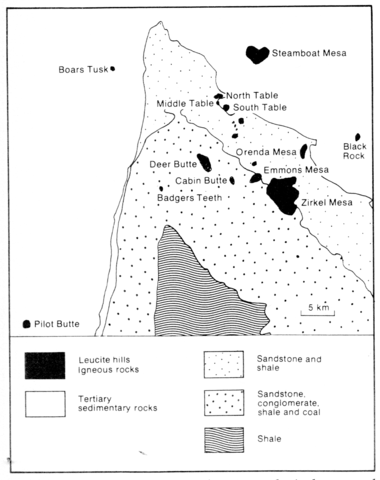stripes
The Leucite Hills extend over an area of about 70x35 km in Sweetwater County on the north side of the Rock Springs uplift, southwest Wyoming; 22 distinct hills were defined, named, described and illustrated by Kemp and Knight (1903). Of these 12 were described as mesas, 6 as volcanic necks, 2 as dykes and 2 as talus covered hills. The mesas comprise horizontal, vesicular or amygdaloidal lava flows, and 7 of them are surmounted by cones up to 76 m high composed principally of pumice. A number of dykes radiate from the volcanic necks. The igneous rocks rest upon a dome of Cretaceous and Tertiary sediments. Xenoliths are found in all the igneous rocks, but are particularly abundant in the volcanic necks and include granite, gneiss, anorthosite, gabbro, harzburgite, pyroxenite, sandstone, siltstone and limestone, together with cognate xenoliths of coarse grained phlogopite, diopside, apatite, priderite and magnophorite with an ocelli texture (Carmichael, 1967, p. 31). All the igneous rocks of the Leucite Hills are highly potassic, three principal rock types being recognized and described by Cross (1897), namely wyomingite containing phenocrysts of phlogopite in a groundmass of leucite, diopside, apatite and possible glass; orendite with phenocrysts of phlogopite in a groundmass of sanidine, leucite, diopside and apatite; and madupite with diopside phenocrysts enclosed poikilitically by phlogopite in a turbid, microcrystalline groundmass of leucite, diopside and apatite. Carmichael (1967) has also described olivine as a phenocryst phase, with magnophorite in the groundmass of wyomingites and orendites, together with accessory Cr-bearing spinels, perovskite, wadeite and priderite. Madupite occurs only at Pilot Butte in the extreme west, all the other localities comprising both wyomingite and orendite, commonly with orendite interbanded with thin layers of wyomingite. A general account of the petrology, with analyses of leucite, feldspar, olivine, pyroxene, phlogopite, amphibole, priderite, wadeite, apatite, perovskite and magnetite, as well as of rocks, will be found in Carmichael (1967), while green pyroxenes from Hatcher Mesa are described by Barton and van Bergen (1981). Kuehner et al. (1981) discuss petrogenesis in the light of petrographic, mineralogical, geochemical and experimental data, and Barton and Hamilton (1979) made experimental studies up to 30 kbar on a madupite; liquidus and solidus temperatures of wyomingite were determined by Sobolev et al. (1975). REE data for these rocks are given by Kay and Gast (1973) and Sr isotopes and Rb by Powell and Bell (1970); Vollmer et al. (1984) discuss petrogenesis in the light of reported Nd and Sr isotopic compositions and Rb, Sr, Sm and Nd concentrations. Sheriff and Shive (1980) have investigated the palaeomagnetism of a wide range of samples.
BARKER, D.S. 1974. Alkaline rocks of North America. In H. Sorensen (ed.). The Alkaline Rocks. John Wiley, London: 160-71.
BARTON, M. and BERGEN, M.J.van 1981. Green clinopyroxenes and associated phases in a potassium-rich lava from the Leucite Hills, Wyoming. Contributions to Mineralogy and Petrology, 77: 101-14.
BARTON, M. and HAMILTON, D.L. 1979. The melting relationships of a madupite from the Leucite Hills, Wyoming at 30 kb. Contributions to Mineralogy and Petrology, 69: 133-42.
CARMICHAEL, I.S.E. 1967. The mineralogy and petrology of the volcanic rocks from the Leucite Hills, Wyoming. Contributions to Mineralogy and Petrology, 15: 24-66.
CROSS, W. 1897. Igneous rocks of the Leucite Hills and Pilot Butte, Wyoming. American Journal of Science, (fourth series), 4: 115-41.
KAY, R.W. and GAST, P.W. 1973. The rare earth content and origin of alkali-rich basalts. Journal of Geology, 81: 653-82.
KEITH, R.E. 1965. Rock Springs and Blair Formations on and adjacent to the Rock Springs uplift, Sweetwater County, Wyoming. Guidebook, Wyoming Geological Association, 19: 43-53.
KEMP, J.F. and KNIGHT, W.C. 1903. Leucite Hills of Wyoming. Bulletin of the Geological Society of America, 14: 305-36.
KUEHNER, S.M., EDGAR, A.D. and ARIMA, M. 1981. Petrogenesis of the ultrapotassic rocks from the Leucite Hills, Wyoming. American Mineralogist, 66: 663-77.
MCDOWELL, F.W. 1971. K-Ar ages of igneous rocks from the western United States. Isochron/West, New Mexico Bureau of Mines and Mineral Resources, 2: 1-16.
POWELL, J.L. and BELL, K. 1970. Strontium isotopic studies of alkalic rocks: localities from Australia, Spain and the western United States. Contributions to MIneralogy and Petrology, 27: 1-10.
SHERIFF, S.D. and SHIVE, P.N. 1980. Paleomagnetism of the Leucite Hills volcanic field, southwestern Wyoming. Geophysical Research Letters, 7: 1025-8.
SOBOLEV, V.S., BAZAROVA, T.J. and YAGI, K. 1975. Crystallization temperature of wyomingite from Leucite Hills. Contributions to Mineralogy and Petrology, 49: 301-8.
VOLLMER, R., OGDEN, P., SCHILLING, J-G., KINGSLEY, R.H. and WAGGONER, D.G. 1984. Nd and Sr isotopes in ultrapotassic volcanic rocks from the Leucite Hills, Wyoming. Contributions to Mineralogy and Petrology, 87: 359-68

